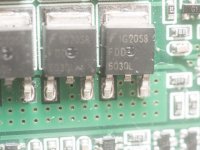Series adapter from hobbyking uses XT60's and 12?awg, hobbyking sells XT60's with wire already soldered to the XT's that you could just solder the wires the way you want. They sell series adapter in a couple different flavors, connector based (does not use any wires) and wire based (uses wire) to make the adapter. Series and parallel, series for the extra voltage (for more rpm) and parallel for the extra Wh or Ah to get more distance.
If making one yourself using XT's connectors and soldering wire on then use the copper bowl cover that clicks in, I like install a bit of heat shrink over the bowl as far down as you can get (to protect it), and lots of heat shrink on the wire side, I try to keep the heat shrink even lengths (for looks) but I dont try all that hard

just make sure the bowl is covered with no wire showing (stripped too much insulation or cut to small a pc of heat shrink)
I wouldnt use any of their other connectors, only the big bullet connectors 4mm or bigger. I find soldering the big connectors easier, but if your doing it yourself, pay attention to heat management as you will melt the housing if your not careful. A pc can or air is helpful to cool things down but dont shock the solder. A small fan blowing on the connector will help cool it down. Generic irons the 40w is good, but I like the 60w generics from Harbor Freight.
I have a couple techniques I use. I touch the inside of the bowl to heat it up, move iron to the outside of the bowl while solder is being applied into the bowl.
Make sure the connector wont move, I like locking pliers and the XT sits in the curved section of the grip real good. They do sell adapters to hold connectors but dont waste your money. For bullets I drill holes in wood to hold the 4mm or bigger bullets.
One connection is fine, but as soon as you have to start unplugging multiple adapters (like Lipo bricks) every charge, mistakes happen when your tired after a day of riding, when you dont have much light, dark or your rushed.
One little "Ooops I connected it the wrong way" and you'll see why! Just hope you dont have to buy a new cheap generic or expensive controller or new battery.



